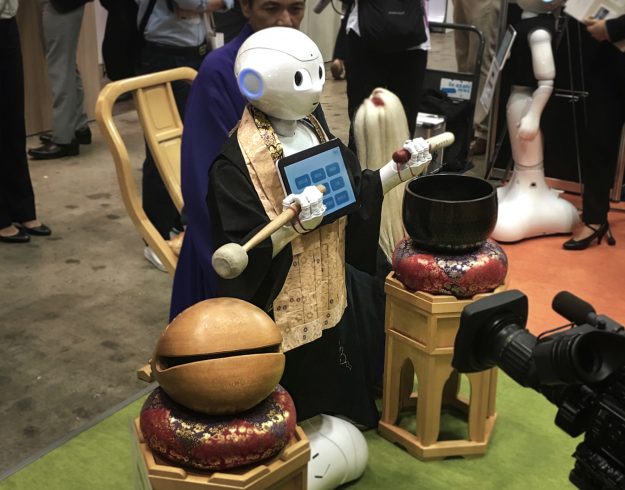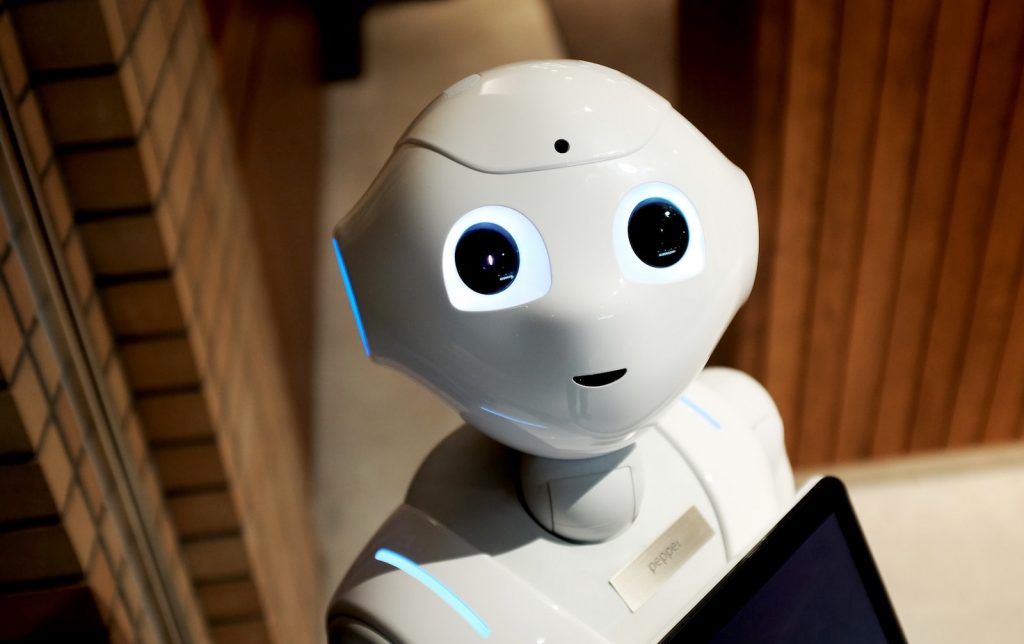This excerpt was adapted from Hannah Gould and Holly Walters’ article “Bad Buddhist, Good Robots: Techno-Salvationist Designs for Nirvana” in the Journal of Global Buddhism.
It’s a difficult time to be a robot. In the media, the increasing use of robotics and AI (artificial intelligence) has been lauded as a progressive way to overcome human deficiencies. But it has also given rise to (more or less substantiated) concerns about ceding control to nonhuman actors. Perhaps the moral objections have come too late. Today, smartphones remember our friends’ phone numbers and birthdays, algorithms curate our online experiences, and ChatGPT writes our students’ essays. Simultaneously, autonomous cars cause accidents, drone strikes blur warfare with video games, and automation threatens job security. The potential scope of automated and robotic interventions in human life appears limitless. But can they also lead us to salvation?
Many contemporary sources, from science fiction films to Silicon Valley developers, offer technological answers to the continued crises of the human condition. These narratives reflect techno-salvationism ideology, which presupposes that technology’s “correct” application to social and ethical problems will result in a better, more moral humanity. As a result, these adventurous stories often blur many age-old conflicts between religion and science to position robotics and AI as the solution to the limitations of earthly human existence. By fusing spirituality with technology, the link between scientific advancement and transcendent belief is set up as the key to solving political conflicts, ethnic divides, and human-caused environmental disasters. In other words, the fix for all human failings is the perfection of the cyborg, by blending what is essentially good about humanity with what is viewed as corrective in technology.
It should come as no surprise, then, that techno-salvationism as a model of thinking often informs the growing use of robots in religious contexts, particularly those that espouse the belief that modernity is a degenerate, final age. Both scholars and religious practitioners have questioned whether or not robots can believe in the ideas they espouse, whether or not they have the emotional capacity to mediate meaningful interpersonal relations, and whether or not they have the sufficient moral capacity to make ethical judgments.
As in the West, the use of robots in Asian Buddhism and Hinduism has grown exponentially in the past few years—from the Tibetanoid Sophia the Robot, the ostensibly Buddhist robot out to “put an end to greed and ignorance,” to the robotic puja arm (bizarrely, also named Sophia), developed by IBM Watson and Patil Automation Pvt Ltd (PAPL), performing the Ganpati Chaturthi aarti (lamp offering) in New Delhi in 2017. By focusing on public ritual performance rather than on states of internal belief or representational modes, these robots represent the logical result of a progression from (human) ritual failure to (robotic) ritual perfection. Indeed, in many ways, Buddhist robots might be called the “ultimate renunciate.” Their absence of desire, greed, bodily needs, or any of the 108 defilements that burden humanity means they are impervious to corruption and thus able to produce perfect practice. Of course, without any defilements to overcome, their capacity to “renunciate” could also be called into question.
Physical discomfort or limited memory capacity have required modest technological augmentation to the practitioner for ritual purposes. For example, various wooden benches and cushions have enabled monastics to maintain a seated position by restoring blood pressure to the legs during long periods of chanting and meditation. More recently, the Taiwanese company Acer has developed Smart Prayer Beads that digitally count the user’s mantra recitations so that they don’t lose track of their place or number and tally them for “merit,” which can be shared on social media. By extension, other, more severe, ritual failings might call for intense mediation of interpersonal relations and politics for practice to be successful.
Technological Advancement as Right Practice
Numerous scholars have noted how an increasing attention to orthopraxy (literally correct practice, often meaning correct ritual performance) has accompanied the globalization of Buddhist traditions and given rise to subsequent concerns over “corruption” and “pollution” that often accompany the movement of religious practices into new cultural contexts.
One of these methods has been to create robots that can replace human actors in performing rites in an “automated” way, where technology produces the capacity to alleviate suffering without itself suffering. Another has been to introduce technologically guided ritual and spiritual performance to mitigate latent human corruption and a penchant for selfishness and ignorance. In other words, it allows artificial intelligence to perform certain actions so that greed, desire, and hatred will not otherwise taint the outcomes. In these two approaches, technology becomes collective salvation, where the individual liberation of the monk or practitioner is no longer the point of the practice but a potentially selfish one, given the growth and continuation of large-scale suffering in the modern age.
The expansion of technology into increasingly broad areas of everyday and ritual life has been met with significant controversy and critique, particularly where it crosses into sacred realms. Contradicting its pervasive image as an ancient and a-materialist (or even “antimaterialist”) philosophy within the West, Buddhism, as an economic and political force, has long contributed to technological development and has routinely benefited from new technologies in the service of materializing the dharma, cultivating mindfulness and awakening, and spreading its teachings. The last two decades of Buddhist studies have also demonstrated that commodification and technology are as much a part of Buddhism as meditation and textual analysis.
Indeed, Buddhism has a history of promoting technological development for religious purposes. There is a long tradition of machines conducting rites across a range of Buddhist schools and historical periods, including mechanized Tibetan prayer wheels, mantra-chanting software, solar-powered lotus lamps that recite the Amitabha mantra at gravestones, iPhone apps for making offerings to the ancestors, and more recently, metaverse meditation spaces and Buddha NFTs. Technological innovation in Buddhism takes the utopian visions of a good Buddhism seriously while simultaneously presenting creative solutions to bad Buddhists.
Pepper the Robot Priest
At the 2017 Life Ending Industry Expo (ENDEX), Japan’s largest convention for the funeral industry, one of the country’s most advanced semi-humanoid robots, known as Pepper, took on a new role as a Buddhist priest. Pepper is manufactured by SoftBank Robotics and is known for its advanced ability to detect human emotions via voice patterns and facial expressions. Pepper, dressed in silk monastic robes, performed the Heart Sutra (Sk. Prajnaparamitahrdaya) in a robotic voice as it struck a large wooden glockenspiel in time. In Japan, reciting this sutra is a common element of memorial services for the recently deceased and ancestors. These services are one of the primary sites of encounter between the public and Buddhist clergy. They are also essential to securing a “good” or culturally normative death in contemporary Japan by facilitating the maturation of the dead through a series of stages toward a state of ancestorhood and residence in the Pure Land. In this role, Pepper performs as a Buddhist priest and assists other nonrobotic humans to become good Buddhists after death. The company presenting the priest-Pepper, plastics manufacturer and technology R&D conglomerate Nissei Eco, announced that a Pepper would shortly be available to rent for funerals nationwide.

From block-printed sutras to shakuhachi flutes, prayer wheels, and rotating sutra depositories, a diverse array of artifacts have been deployed throughout Japanese Buddhist history for merit generation and propagating the dharma, including recently. In 2016, Takarashiji Temple in Kyoto created the robot double of the main priest, named “Au,” who performed a Buddhist service. In 2018, Ryūganji Temple in Kyoto launched a “drone Buddha” performance featuring miniature 3D printed statues of Amida Nyorai, Kannon Bosatsu, and Seishi Bosatsu that hover in locations around the main hall to represent the scene of “Amida Coming over the Mountain.” And in 2019, an “Android Kannon” named Mindar, with an anthropomorphic face and mechanized body programmed to deliver Buddhist sermons, was developed by Zen Kodaji Temple in collaboration with Ishiguro Hiroshi, the director of the Intelligent Robotics Laboratory at Osaka University. More broadly, a range of online altars and iPhone apps allows users to participate in virtual ancestor veneration and automated robotic delivery systems to manage storage and access human ashes.
The proposed fee for hiring Pepper for a Buddhist memorial service, approximately USD 400, is substantial and rivals the cost of hiring a human priest. Pepper also appears particularly ill-suited to the dramatic performance of sutras. It cannot modulate its vocal tone or grasp objects, so ritual implements must be lashed to its arms rather than held. If correct ritual performance is the measure of a good Buddhist robot, then Pepper’s performance at the funeral industry expo demonstrates the remoteness of this future. However, the current capabilities of the robot system, or the likelihood of its eventual deployment, is perhaps less important than its ability to generate an atmosphere of innovation. At least part of the strength of technological innovation is its ability to generate optimistic enthusiasm for a future yet to come, thereby shielding us from future failings. Measured against this benchmark, Pepper appears to do well.
Still, the Pepper priest service is yet to become commercially available (let alone viable) throughout Japan, and two years after its 2017 launch, no funeral services with Pepper had been booked. As is often the case, these examples suggest that today, at least, robots exist primarily in our imaginations.
Utopias belong to the present moment. They tell us that the present future of Buddhism is increasingly imagined as post- or transhuman, deploying human ingenuity to transcend human weaknesses toward a technological perfection of practice. Indeed, the logical outcome of the perfection of Buddhist practice, by both monastics and laity, might be the elimination of human Buddhists. However, robots are gods of our own making, and when Buddhists, with all their human failings, fill the gaps of ritual failure with technology, they also reproduce the things they mean to transcend.
Thank you for subscribing to Tricycle! As a nonprofit, we depend on readers like you to keep Buddhist teachings and practices widely available.
